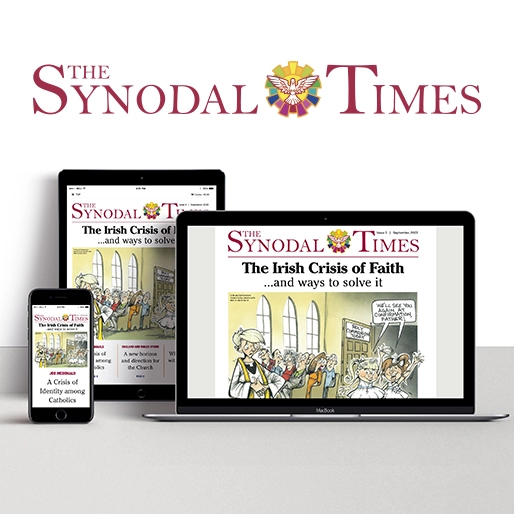The experience of the Synod
To many of those taking part the synod was a revelation. People remarked on the novelty of speaking freely and being heard in organised conversations that were open- ended and attentive to the movements of the Spirit. They spoke of how, after decades of churchgoing, they had been asked to speak for the first time.
The resistance of a portion of the clergy to the synod process is remarked on in many reports. Special mention is made of the mistrust of some former Anglican priests who cited negative experiences of synodical parliamentary-style governance of the Church of England, with its motions and votes, pressure groups and campaigns, which “are not easily forgotten”.
While the synod roles of ordinary faithful and the bishops were clear, that of the clergy was more uncertain.
A wounded call to conversion
The reports show people’s passion for the Church to be what they believe Jesus Christ calls it to be; they are frustrated and critical when it falls well short. From the reports emerged a powerful message that
There is a real sense that the Church requires healing and conversion to live out its own nature and purpose to the full.
(i) A Church that embraces
A desire for churches to be places of closeness is a striking feature of the reports, expressed in the word welcome, along with related words such as integration and inclusiveness. There is a constant call for the Church to embody God’s unconditional embrace of all, not least the stranger and the marginalised, and criticism that the Church is often unwelcoming either to specific people, or to new ideas and inspirations.
(ii) Priests who enable
There is great love of parish priests, cherished as “holy men who care deeply for those that they serve”. People are aware of the heavy workload carried by clergy managing more than one parish community, and want them to be relieved of the burden of non- priestly tasks to focus on pastoral and liturgical activity. The reports highlight the need for a change in the way priests and lay people relate in order to see themselves as both responsible for the mission of the Church. This was one of the strongest constant themes in the submissions.
There is criticism of “routine celebration, mediocre liturgy and homilies that do not speak to the real world”. Poor homilies are attributed to overworked, distracted or poorly trained clergy. This criticism is often accompanied by a call to allow women to preach.
(iii) The Church as ‘other’
Lay faithful feel disempowered: “the laity felt that things were ‘done to them’” rather than with them. Decision-making and initiative are seen as the prerogative of the clergy. Potentially “synodal” bodies – parish and deanery councils – have little or no impact, a point that is repeatedly recognised and regretted. Yet the reports consistently call for more of them, and for them to include a broader range of people and to have more impact.
The distance felt by ordinary faithful from the organs of governance of the Church is expressed most vigorously in criticism of the sex abuse crisis. The crisis is seen as a dramatic indictment of clericalism, of an institution seen as self-serving rather than serving, concerned with itself and its own reputation.
(iv) The art of accompanying
Running through the reports is a clear vision of how the future can be different when all the People of God – lay, Religious, clergy, bishops – act together, in their distinct roles and functions, but all as missionary disciples. A call for greater participation and collaboration is a constant.
(v) The desire to be formed
For many, the dream of a Church of collaboration and shared mission goes along with a passionate call for “training for lay leaders to encourage the formation of missionary disciples”. The thirst for formation is a striking and constant feature of almost every synod submission.
They desire formation in Church teaching, Spirituality and Scripture, as well as practical tools and skills to enable discipleship: missions, retreats, adult catechesis, spiritual formation, and so on.
(vi) The call to communicate
The lack of co-responsibility was critiqued also in terms of the Church’s communication, which can either be an enabler or a barrier to synodality.
“There are no mechanisms for listening, mutual input or communication between laity and hierarchy. Consultation is virtually non-existent,” is a common complaint. “The laity are simply not informed of what is happening and why.”
Truth, mercy and welcome
The vision of a Church, one that does not firstly judge and exclude but unconditionally embraces, lies behind strong critiques in the reports of the way the Church teaches, presents itself, and operates.
There is regular mention of the need to re-examine sacramental disciplines, above all those that restrict access to matrimony, holy orders and the Eucharist..
The model of a welcoming Church was perceived to be particularly compromised by the failure to integrate certain groups particularly in the case of three categories – women, LGBTQ+ people, and young people.
‘Marginalised’ groups
(i) Women
The place of women within the Church was the cause of “passionate, repeated and strongly expressed concern” in the synod listening. It was a constant theme, occupying substantial sections of every diocesan report, and should be regarded as one of the headline findings of the synod in England and Wales. The exclusion appears broadly under two categories: the failure to make good use of the contribution of women in the Church, and the issue specifically of women’s formal ministries.
On the whole women were not considered a marginalised minority so much as a silenced, unrecognised majority. Despite being the “lifeblood” of the Church, women are seen as excluded from the leadership and ministry roles that correspond to them in ways that are both self-defeating and damaging to the Church’s mission and credibility.
Sadness and frustration that “women’s opinions were not taken seriously or felt judged to be second class” permeate all the reports. A minority contest the idea that women were excluded or not valued.
(ii) LGBTQ+
LGBTQ+ groups who organised synodal meetings in Westminster diocese were grateful for a twice-monthly Mass specifically for them but otherwise felt they were “rendered invisible”. A constant voice in the reports laments the exclusion and sidelining of LGBTQ+ Catholics.
Church teaching was commonly raised, as well as the language in which that teaching is expressed, notably the expression “intrinsically disordered” that some church documents use to describe the same-sex orientation..
(iii) Young People
The absence from the Church of young people was another common theme, but often spoken on behalf of rather than for themselves. Present in almost every submission was the pain in the older generation at the absence of young people from the Church, along with a bewilderment that the means of passing on the faith in a previous generation through family and parish had broken down. The question was often voiced: “how can we encourage them to come back?”
(iv) Divorced and remarried
Those who are divorced and remarried without an annulment were mentioned often as a marginalised group in the Church who “expressed great hurt at their exclusion” from the Eucharist. There was a perception of injustice, “particularly where the innocent party is concerned”, along with criticism that rules barring them are “unnecessarily dogmatic and hurtful on the part of the Church”.
(v) The Traveller Community
A number of submissions mention the Traveller community, helping them to feel welcome and at home, and understanding their needs. One submission talks about the community wanting to be more involved in parish life and included in parish ministries. “Catholic Traveller families generally expect not be welcomed in parish communities up and down the country”.86
(vi) Those with additional needs
The voices of those suffering degrees of incapacity – whether deafness, blindness, mobility, learning difficulties, etc. – have called in this synod for attention to be given to their needs. They want to participate more in the life of the Church.
(vii) People of colour
The racial and cultural diversity of Catholics is seen as one of the great gifts of the Church in England and Wales. However, this diversity is not reflected in leadership roles in the Church, which are “almost exclusively white”, which produces a sense among some people of colour that “decisions are not made by us, but are instead made for us”.
(viii) Traditionalists
Although very few in number, a sense of grievance and marginalization is strongly expressed by those who worship using the Missal of 1962. In response to questions about marginalisation and exclusion, both TLM adherents and those committed to “maintaining traditional Catholic teaching against what they interpret as harmful modifications” feel “badly treated by the bishops and by Pope Francis.
Towards a synodal Church in England and Wales
The experience of the synod, while stumbling and uneven, has “begun something momentous” in the People of God of England and Wales.
There is a felt desire in the reports that the synodal process now be embedded in dioceses and parishes, and that structures and formation be introduced at every level to enable this. There is a consistent call for formation in synodality, including a better understanding of how it was lived in the early Church and developed in the different Christian traditions.
The path to a synodal Church requires reviewing and removing obstacles to listening and participation. The reports hope for a “new leadership style” that reflects a relationship between priests and lay faithful of collaboration and co-responsibility, and for structures that facilitate dialogue, discernment and participation in decision- making processes, while respecting that decision-taking is the task of designated authority.
Without yet identifying concrete steps, many reports announce diocese-wide conferences over the next year to reflect on the fruits of the synod listening, stressing that such reflection should not need to await the outcome of the synod’s conclusion in Rome in October 2023.
Becoming a synodal Church means listening better, sharing information more broadly, and becoming more transparent and accessible. It means making better use of digital platforms and social media to develop a more networked, horizontal style of communication.
Along with the thirst for formation is a dream that the disconnect between Church and world be bridged by ordinary faithful “who know where they stand” (St John Henry Newman) and who can express their convictions in ways that are clear, confident, and joyful.
Conclusion
Coming out of the pandemic, the synod has opened a new horizon and direction for the Church in England and Wales, awakening in the faithful a desire for discipleship and the call for a new way of living and thinking that deepens communion, enables participation, and equips all for mission. It is an invitation that must be acted on, lest the hope the Spirit kindled in the hearts of the faithful grow faint.



